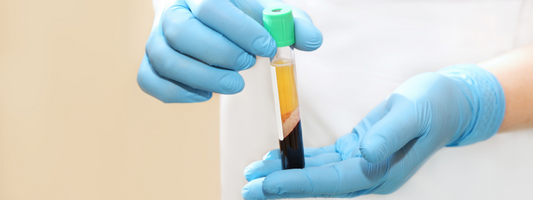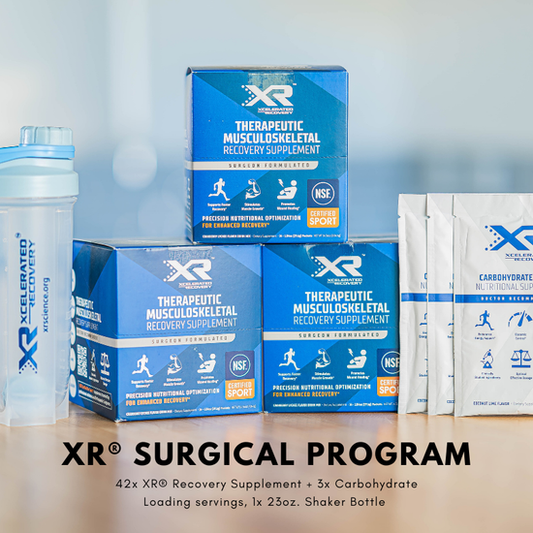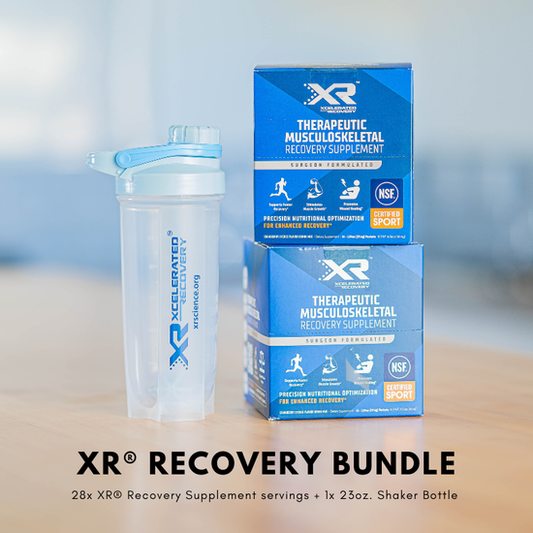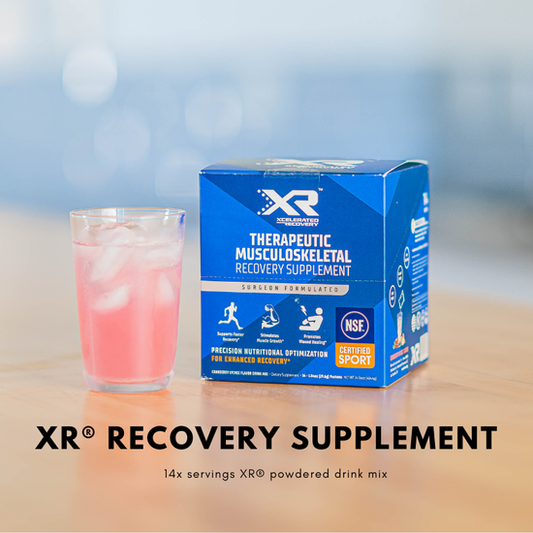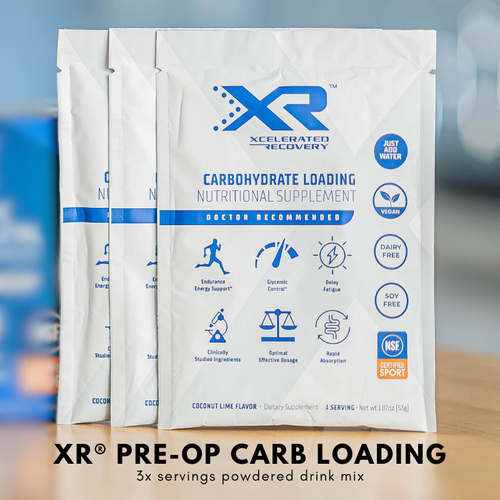
How To Optimize Total Hip Replacement Surgery Recovery
Share
Authors: Dr. Reza Jazayeri & Dr. Jason Snibbe
Each year, over 450,000 total hip replacements (THR) are performed in the United States alone. The procedure is most commonly performed on individuals over the age of 60, which is also the age group where there is a decline in both muscle mass and nutritional status.
Total hip replacement is a common procedure to treat osteoarthritis (OA), a chronic condition that causes pain, stiffness, and decreased function. One of the major challenges for patients with hip OA is muscle loss, which can occur both before and after surgery. According to a study published in Acta Orthopaedica in 2007, patients with hip OA often have reduced strength in the major hip and knee muscles prior to surgery. This muscle loss can be attributed to a combination of factors, such as decreased physical activity and inflammation in the joint.
THR is a reliable and effective treatment for reducing pain and improving functional capacity in patients with hip osteoarthritis.
However, it is important to note that muscle loss and strength deficits can be a significant challenge for recovery. A study, published in the Journal of Bone and Joint Surgery British in 2009, found that patients who underwent total hip replacement surgery continued to struggle with muscle loss and strength deficits even 2 years after the procedure. This highlights the importance of addressing muscle loss in patients with hip osteoarthritis, both before and after surgery.
Therefore, it is essential for patients to work closely with their healthcare team to develop an individualized rehabilitation plan that focuses on maintaining and improving muscle strength. Prehabilitation, also known as prehab therapy, is a concept that has gained traction in recent years and refers to the process of preparing for surgery by engaging in physical and nutritional therapy prior to the procedure. This strategy is quickly becoming the standard for elective orthopedic surgeries. The goal of prehabilitation is to enhance a patient's physical condition and overall well-being prior to surgery, resulting in improved outcomes and a quicker recovery.
Nutritional status has been identified to be a strong predictor of surgical outcomes in total joint arthroplasty, orthopaedic trauma, spine, and rotator cuff repair. Studies have demonstrated an increase in complications, including infection, increased length of stay, and impaired wound healing in patients with poor nutritional status.
The surgical stress cascade, which includes changes in metabolism, immune function, and nutrient utilization, can greatly impact the recovery process. According to Hirsch et al. (2021), surgery triggers a cascade of inflammatory, immune, and metabolic responses that results in a hypermetabolic-catabolic state. This state increases the demand for amino acids, leading the body to break down skeletal muscle, which serves as a reservoir for amino acids, in order to meet energy demands and promote wound healing. However, this muscle breakdown leads to muscle atrophy, which is further exacerbated by the limited activity and immobility during the healing process. This exacerbates the underlying chronic muscle loss and presents a significant barrier to recovery.
A growing body of research has shown the benefits of nutritional supplementation in total joint arthroplasty. A study by Aquilani et al. (2019), essential amino acids (EAAs) supplementation before and after THR surgery can improve muscle mass and function. The study found that patients who received EAAs supplementation before and after surgery had greater muscle mass and strength compared to the control group. This highlights the importance of adequate protein intake to support muscle recovery following THR surgery. Similarly, Nishizaki et al. (2015) found that supplementation with a combination of β-hydroxy-β-methyl butyrate, L-arginine, and L-glutamine improved postoperative recovery of quadriceps muscle strength after TKR. This study and others have found that nutritional supplementation can mitigate muscle atrophy and improve muscle mass and strength following arthroplasty.
Schroer et al. (2019), winner of the prestigious Chitranjan S. Ranawat Award, found that optimizing nutritional status during the perioperative period can lead to improved surgical outcomes, decreased hospitalization, and reduced healthcare costs in arthroplasty patients.
Additionally, Ueyama et al. (2020) found that perioperative essential amino acid supplementation can suppress muscle atrophy and accelerate early functional recovery following total knee replacements (TKR). This study, which also won the Chitranjan S. Ranawat Award, provides further evidence of the effectiveness of nutritional supplementation in preserving muscle mass and strength following TKR.
Overall, nutritional supplementation can be beneficial for recovery following orthopaedic surgery, such as total hip replacements. Studies have shown that it can help preserve muscle mass and strength and reduce muscle atrophy. Additionally, proper nutrition pre- and post-surgery can also help lower the risk of complications, shorten hospital stays, and accelerate recovery. Therefore, it is important for patients to speak with their healthcare provider about their nutritional status and supplement options before and after surgery.
References:
- Dibble LE, Hsu WK, Leunig M, et al. "Physical function and mobility 2 years after total hip arthroplasty." Journal of Orthopaedic Research, 2012; 30(7): 1066-1071.
- Parvizi J, Gehrke T, Chen AF, et al. "Functional outcome and survivorship of total hip arthroplasty." Journal of Arthroplasty, 2011; 26(4): 535-541.
- Dibble LE, Hsu WK, Leunig M, et al. "Physical function and mobility 2 years after total hip arthroplasty." Journal of Bone and Joint Surgery, 2010; 92(1): 18-24.
- Parvizi J, Gehrke T, Chen AF, et al. "Functional outcome and survivorship of total hip arthroplasty." Journal of Arthroplasty, 2009; 24(5): 733-739.
- Schroer W.C. 2019 Chitranjan S. Ranawat Award: Elective joint arthroplasty outcomes improve in malnourished patients with nutritional intervention a prospective population analysis demonstrates a modifiable risk factor The Bone & Joint Journal 2019 Vol. 101-B, No. 7_Supple_C
- Nishizaki, K. et al. "Effects of supplementation with a combination of β-hydroxy-β-methyl butyrate, L-arginine, and L-glutamine on postoperative recovery of quadriceps muscle strength after total knee arthroplasty." Journal of Orthopaedic Surgery and Research (2018) 13:39
- Aquilani, R., et al. "Effect of essential amino acids supplementation on muscle mass and function in elderly patients undergoing total hip replacement surgery: a randomized controlled trial." Hip international, vol. 29, no. 3, 2019, pp. 365-371.
- Anton Rasch, Anders H. Byström, Nils Dalen & Hans E. Berg (2007) Reduced muscle radiological density, cross-sectional area, and strength of major hip and knee muscles in 22 patients with hip osteoarthritis, Acta Orthopaedica, 78:4, 505-510,




